Thank you CIA for our air shield!
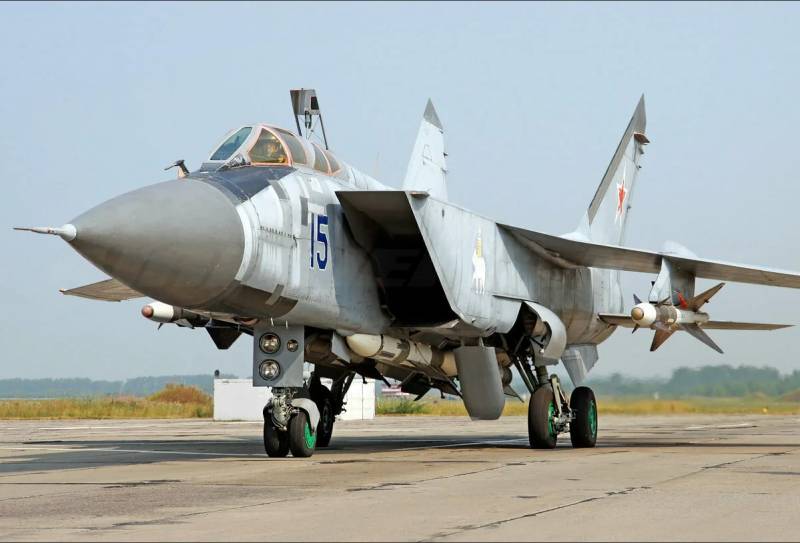
Who is talking about what, and we are again talking about balloons, balloons, probes, balloons and holes in them. Although no, we are still talking about airplanes. But about airplanes, the appearance of which we owe precisely to balloons and balloons. It was because of them that the crown of creation of the Soviet aircraft industry, the MiG-31 fighter-interceptor, appeared, which still has no equal in the world. But first things first.
It all started about 10 years after the end of World War II, when the Soviet Union and its Warsaw Pact satellites were under siege. Moreover, the siege was so real, and even in the air.
That's right, the NATO countries arranged all this precisely with the help of various aircraft such as a balloon. At high altitudes, beyond the reach of anti-aircraft guns and missile systems, and even more so, aircraft, balloons carrying reconnaissance equipment, leaflets, and could carry bombs in the future, drifted into the airspace from the territory of Western countries.
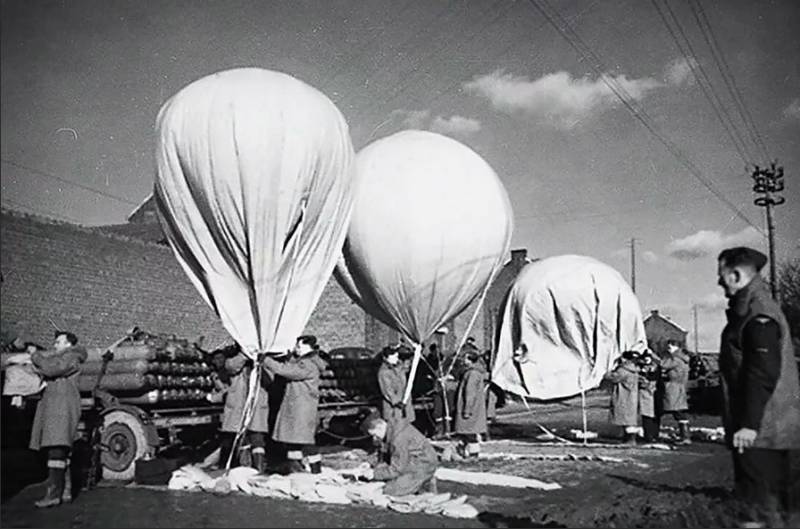
67 years before a US Air Force F-22 shot down a week-long Chinese reconnaissance balloon off the coast of South Carolina over the United States, the Soviet Union engaged in a balloon battle on a much larger scale.
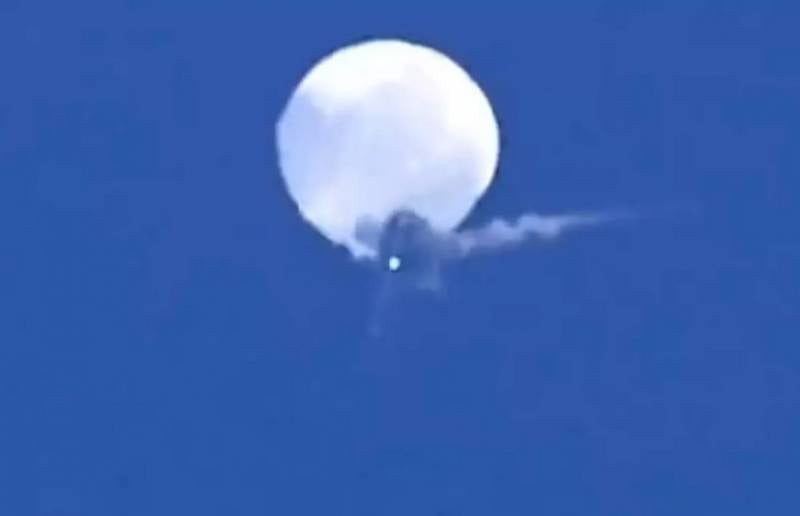
Some of these balloons penetrated more than 1 kilometers from the Soviet border inland. According to Russian archives, between 500 and 1956, a total of 1977 balloons were found over the territory of the Soviet Union, of which only 4 were shot down by fighters. Although some of these balloons were owned by civilian research organizations, most of them were expectedly used for military purposes.
Spy balloon activity peaked in January and February 1956, when nearly 2 balloons were launched. After that, they were observed much less frequently, except for short periods of increased intensity. Many years later, in December 000 and January 1980, the Soviet air defense system recorded the presence of several hundred balloons.
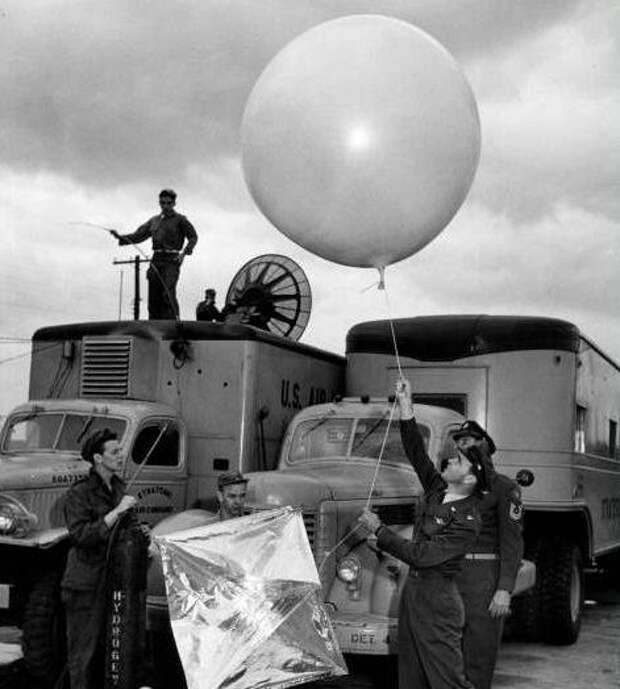
The balloon, despite its simplicity, is capable of much. For example, take air samples over certain objects. The nuclear enterprises and test sites of the Soviet Union were very interesting.
During one sampling period, from August 11 to September 14, 1975, 10 balloons were found drifting over Soviet territory at an altitude of 000 to 15 meters. They were attacked by interceptors of the Soviet air defense forces, including MiG-000, MiG-11, Tu-19, Su-21TM and Yak-128P fighters. Sometimes a whole squadron of 15 aircraft operated against one balloon. Of these 28 balloons, 12 were shot down.
In two cases, it was found that although the balloon was not hit, the equipment carried by the balloons was destroyed. Another balloon was not damaged. Average ammunition consumption was high, with 1,4 air-to-air missiles, 26 unguided rockets and 112 cannon rounds per balloon. In principle, the expense is not so deadly, but if you multiply the numbers by hundreds of launched balloons, it becomes clear that the war was very cruel.
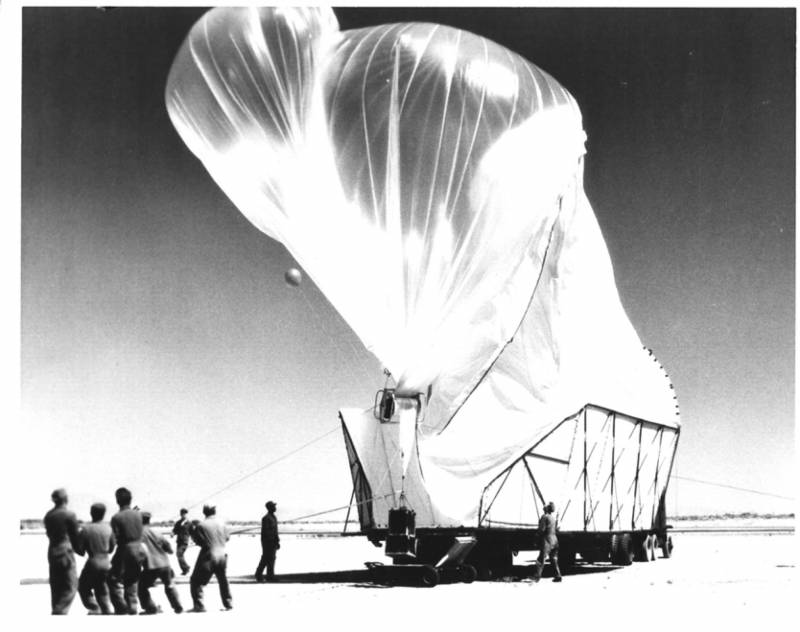
When balloons practically filled the airspace of the USSR, it was only natural that the government began to take urgent measures.
At an accelerated pace, anti-aircraft missiles of the S-25 Berkut and S-125 Neva complexes were modernized in order to teach them to "see" and hit objects such as balloons. Design Bureau just as hastily worked on radars capable of detecting such an inconvenient and low-contrast target as a balloon.
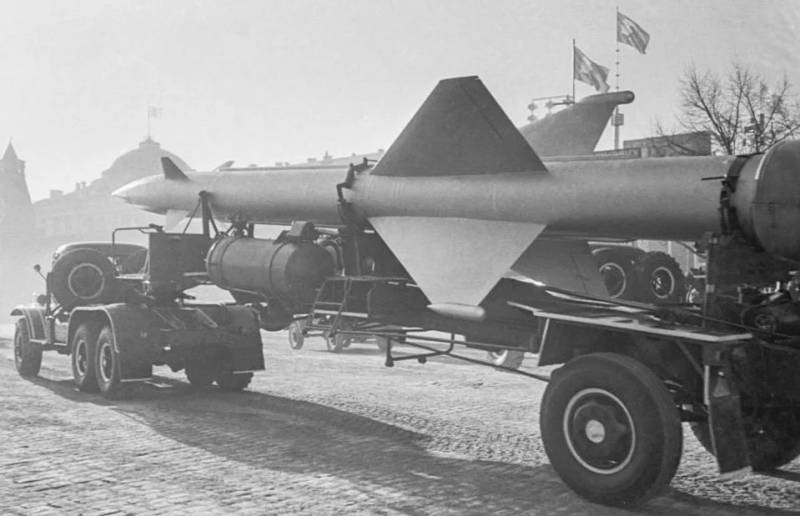
Naturally, they did not sit idly by aviation KB. There, too, work was underway on interceptors of balloons, especially since the air defense already had an idea of \u50b\uXNUMXbwhat kind of aircraft they needed. And in the early XNUMXs of the last century, work began on very peculiar projects.
The development of Soviet interceptor aircraft capable of fighting high-altitude balloons began in August 1951, when the Council of Ministers instructed several design bureaus to prepare proposals. Aerostat interceptor aircraft were not required to have high speed, since their targets were not distinguished by high speed, which depended solely on the wind. The most important factor was the ability to reach very high altitudes, as well as to maneuver once there.
Because radar was not very effective at detecting and tracking balloons, the aircraft had to be fitted with an electro-optical sight. The armament was supposed to be a rapid-fire cannon capable of hitting balloons flying well above the ceiling of the fighter.
Yakovlev Yak-25PA
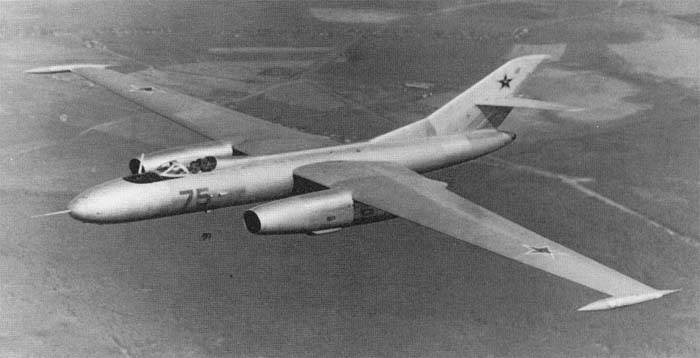
In November 1951, the Yakovlev Design Bureau, which specialized in high-altitude reconnaissance aircraft, presented a project for the Yak-25ASH (Yak-25PA) balloon interceptor aircraft, which was made on the basis of the Yak-25RV high-altitude reconnaissance aircraft, which had a larger straight wing than the swept wing of Yak-25. The armament of the aircraft was to be a double-barreled gun GSh-23 in a mobile turret.
However, the project was abandoned due to the R-11V-300 engines, which could not lift the aircraft to a height of more than 14 meters.
But the Yak-25 was shot down by automatic drifting balloons (ADA) quite often. Moreover, not only the border regiments had to work according to the ADA, but also those that were in the depths of Soviet territory. So in 1960, the pilots of the 146th GvIAP shot down an ADA in the Cherkassy region. But the work of fighter pilots on the Yak-25 is generally worthy of a separate story.
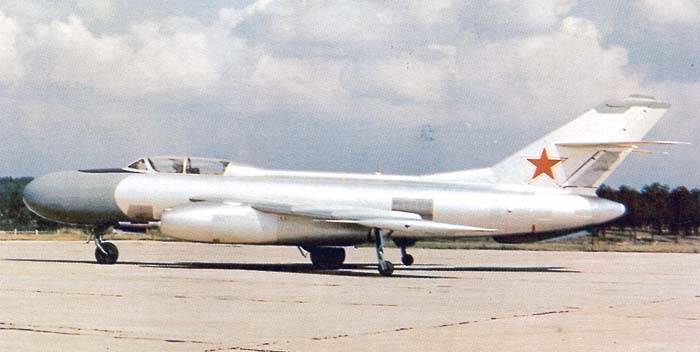
It was not an easy task to destroy a reconnaissance probe that was slowly sailing and had relatively low radio visibility. It was possible to capture the target with the help of the RP-6 from a distance of about 2 km. Moreover, the mark on the radar screen was given by the suspension, and it was necessary to shoot at the ball, which had to be aimed visually at the marks on the windshield. It was dangerous to get carried away with the attack, since the plane could collide with the balloon, so only a few seconds remained to open fire. And yet, the crews of the Yak-25 coped with such tasks, although there were losses.
The Yak-25PA project was abandoned in favor of the development of another design bureau, Myasishchev. Yes, by the 70s, the Yak-25 had finally left the stage, so the work of a group of engineers from Myasishchev Design Bureau, which was carried out on an initiative basis, came in handy.
Myasishchev M-17 "Geophysics"
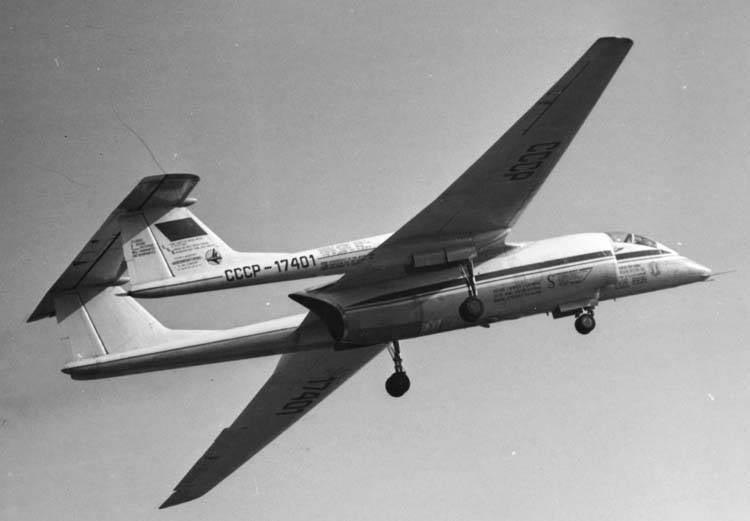
The M-17 was a twin-boom aircraft equipped with a single turbojet engine mounted at the rear of the short fuselage. The most powerful Soviet turbojet engine available, the RD36-51V Kolesov Design Bureau, was chosen. The aircraft could quickly climb to high altitude (35 minutes to 20 m), but its flight lasted only two hours, unlike the American U-000, which climbed slowly but flew over very long distances.
A special electro-optical sight was made for the M-17, capable of detecting a balloon with a diameter of about 30 meters from a distance of 20 km and then automatically tracking it. Plus, the equipment was also a laser rangefinder with a range of about 7 km.
Aiming the cannon with the help of the entire aircraft, as was typical for a fighter, was impossible in this case. Maneuverability at such heights left much to be desired. Therefore, a BD-17 gun turret with a double-barreled 59-mm GSh-23 cannon and a supply of 23 rounds was developed specifically for the M-500. This would allow the aircraft to fight balloons flying at an altitude of more than 4-5 thousand meters above the interceptor, the ceiling of which was fixed at 21 meters.
Tests of weapons systems were carried out in a very interesting way: the nose honor of the M-17 was built into the nose of the Tu-16 bomber. This is how complex maneuvers such as approaching a practically stationary ball at high speed were studied and practiced. There was catastrophically little time for aiming, so such things were worked out in similar conditions.
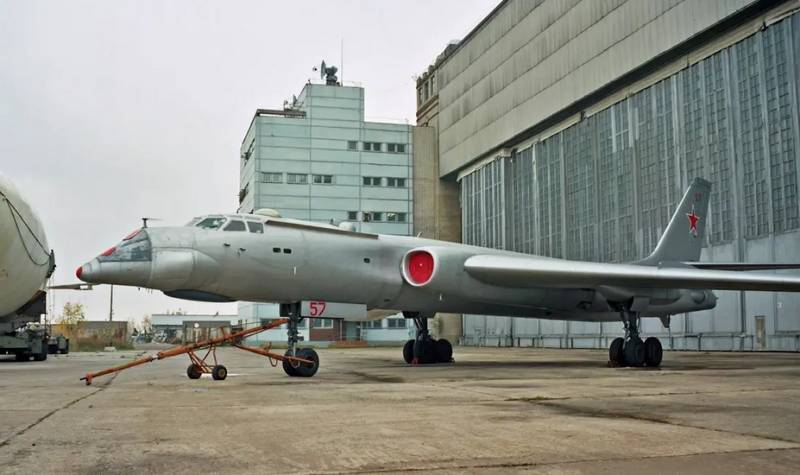
An experimental Tu-16 aircraft with an M-17 nose at the Myasishchev plant in the 1990s.
On one of the two M-17s exhibited at Monino a few years ago, a model gun turret was installed on the upper part of the fuselage. In fact, this plane never flew in this form, it never came to the tower. The third copy of the M-17 flew with cannons, and during tests it very successfully shot down balloons at altitudes from 9 to 21 km.
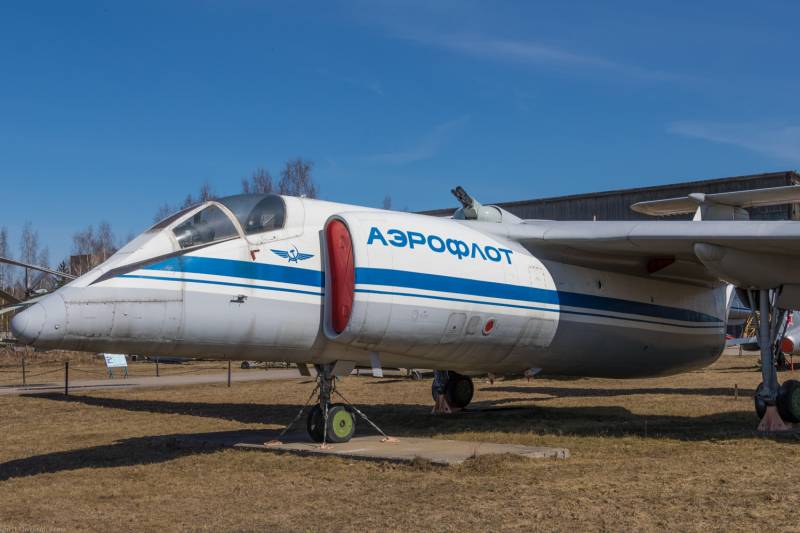
In the spring of 1990, the aircraft set 25 world records for altitude, speed and rate of climb for aircraft weighing 16-20 tons, equipped with one turbojet engine.
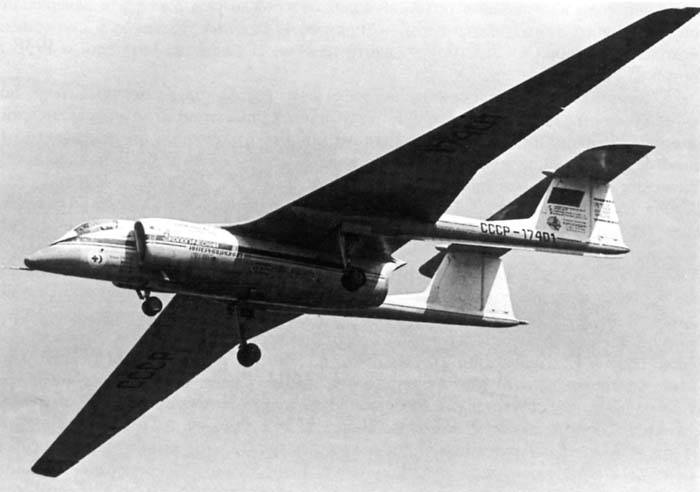
In general, the task of creating a balloon fighter was solved, but this happened when the need for it disappeared. By that time, agreements had been concluded not to launch ADA into the airspace of other countries. The experience gained during the work on the M-17 "Stratosphere" was used to create the next high-altitude aircraft, the M-55 "Geophysics".
Beriev A-60 "Drift"
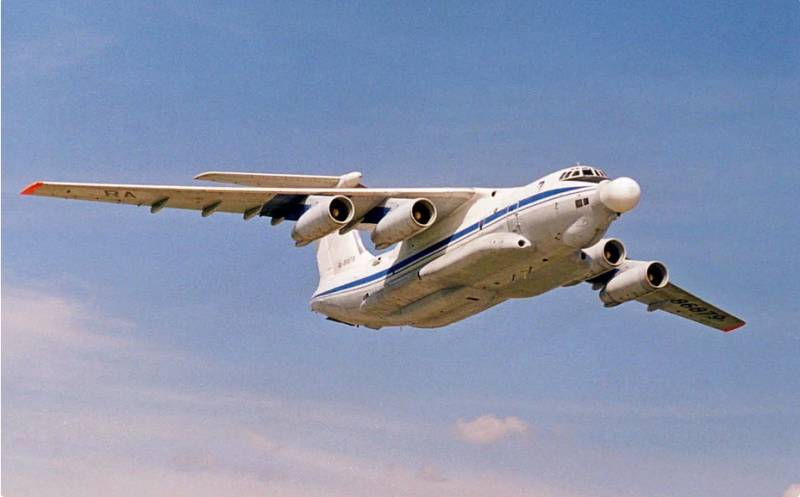
Back in 1975, when the first M-17 was still under construction, and in the West only dreamed of Star Wars, work began in the USSR on another plan to combat high-altitude balloons. The Moscow company NPO Almaz (Yes, now Almaz-Antey Corporation), mainly engaged in anti-aircraft and anti-missile systems, began designing a carbon dioxide laser gun that was to be installed on an Il-76 transport aircraft, thus creating a combat system with balloons "Drift".
Laser. In 1975
The task of lifting the laser system into the air was assigned to the Beriev design bureau in Taganrog. As part of the work, it was necessary to convert the Il-76MD transport aircraft into a laser gun carrier called the A-60. Beriev, in addition to traditional hydroaviation, which was mainly engaged in design bureau from Taganrog, also made special-purpose aircraft. Tu-142MR, A-50 and A-100 one way or another were the developments of Beriev Design Bureau.

The first experimental A-60, known as "Product 1A", made its first flight on August 19, 1981. The laser gun of the aircraft was located in the cargo hold. The fuselage had a large fairing covering the mirror system, with which the laser beam was directed to the target. The laser cannon had a range of about 40 kilometers and was capable of "firing" for a total of 50 seconds, at least according to the design specification. The test results showed a shorter operating time: about 11 seconds.
The target designation system consisted of a Fazotron-NIIR Ladoga radar with an upwardly directed Cassegrain antenna with a diameter of 1,5 meters, installed under a large lamp fairing in the nose of the aircraft, and a laser rangefinder. The balloon could be detected and tracked from a distance of up to 60 km.

Radar "Ladoga-3" for the A-60 aircraft in the museum of the company "Fazotron-NIIR" in Moscow. Photo: Petr Butovsky
On April 27, 1984, a combat test of the A-60 took place. The laser installation damaged a target ball flying at an altitude of 10 meters. "Damaged" - I think that I successfully burned a certain number of holes. Not fatal, because the helium pressure in any balloon is low, and therefore it will come out slowly. To combat this phenomenon, it was necessary to invent highly sensitive fuses even for aircraft shells, because there were simply few holes from shells.
End of story with Soviet ADA interceptors
History M-17 Myasishchev and A-60 Beriev as air interceptors ended rather abruptly, even before the completion of their tests. In the second half of the 1980s, the Air Force's interest in these aircraft began to fade, as the balloons themselves appeared less and less. One of the last such incidents occurred on September 3, 1990, when a drifting balloon was shot down by a Su-15TM interceptor at an altitude of 12 meters in the Murmansk region.
Other uses have been found for both of these aircraft. The M-17 interceptor balloon was converted into the M-17RM high-altitude reconnaissance aircraft, otherwise known as the M-55. The aircraft received two D-30V12 engines instead of one RD-36-51V and 5 aircraft were manufactured, one of which, called Geophysics, is still flying. True, the aircraft is used for scientific purposes.
The A-60 is still a laser cannon platform, but is no longer designed to shoot down balloons. After a long break, the air combat laser project was resumed on December 23, 2002, when the Russian Ministry of Defense signed a contract with NPO Almaz for a new Sokol-Echelon research program. This has provided the A-60 with a new role: its laser cannon is now expected to "dazzle" the infrared sensors of enemy reconnaissance satellites.
Flight testing of the updated A-60-1A2 resumed around 2006. The final part of the test included a "combat" experiment on August 28, 2009, when an A-60-1A2 fired at the Japanese Ajisai satellite at an altitude of 932 miles, and the reflected signal was registered.
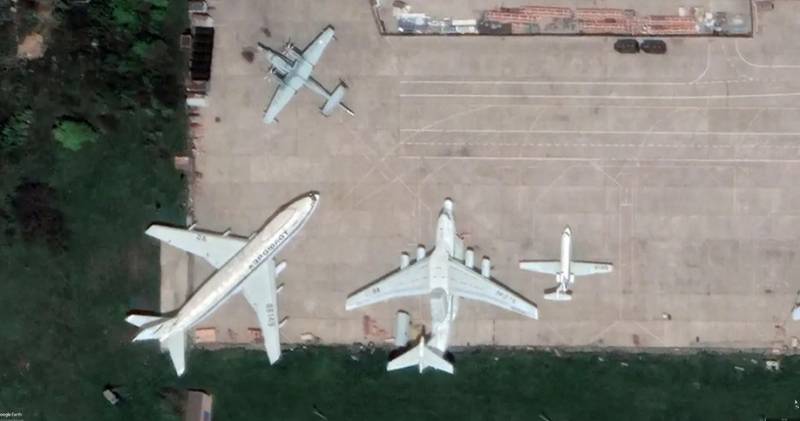
A-60 at the airfield of Beriev Design Bureau in Taganrog in May 2021
This, of course, is a completely different story.
At the moment, the story with Soviet ADA interceptors has come to an end, but since surveillance balloons have reappeared in the airspace, both balloons and interceptors are too early to write off.
And here we come close to what was said at the beginning. About MiG-31
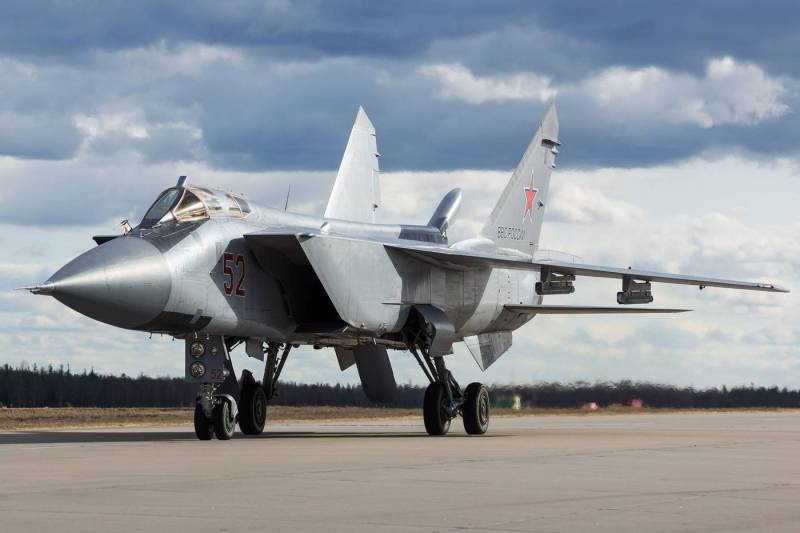
All the same 1975. The Beriev Design Bureau is testing a laser on the Il-76, and the Myasishchev Design Bureau is working on the M-17. The air borders of the USSR are guarded by the MiG-25, just a chic car, especially a practically new fighter-interceptor that entered service in 1970. That is, the very beginning of a career.
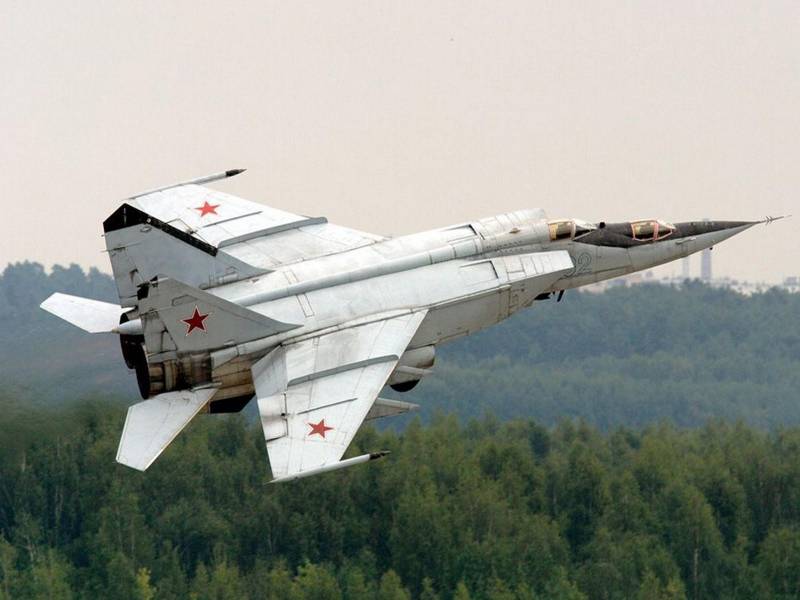
high-rise. It was on the MiG-25PU on August 31, 1977 that test pilot A. Fedotov set an absolute world record for flight altitude of 37 m. Fast. The flight speed of the combat interceptor MiG-650P at full afterburner of the R-25 engines corresponds to 15 km / h with full missile armament - 3000 R-4 missiles, which create high drag and weigh about 40 tons.
Without missiles, the MiG-25P could fly even faster, up to M = 3,2 (3400 km / h) and even more. This is probably the only aircraft in the world for which there was a real speed limit. The reason was the heating of the airframe structure at speeds above 2500 km / h, because speeds above 3000 km / h were allowed to be developed for short periods of time.
But even this was enough for the MiG-25 to calmly get away from any aircraft and missiles of its time.
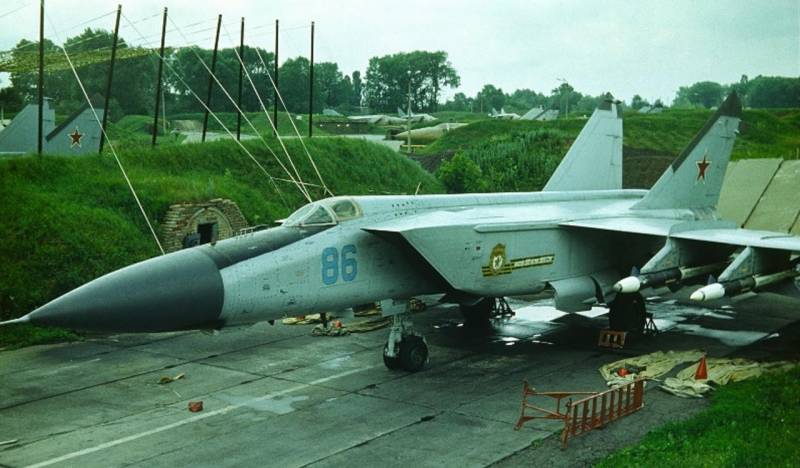
Armament - 4 missiles, usually 2 with thermal seeker, 2 with radar. Enough to destroy almost any aircraft (and not even one), but ...
In 1975, the MiG-31 took off for the first time. Built on the basis of the MiG-25, but a fundamentally new aircraft that took all the best from its predecessor and became the first fourth-generation Soviet fighter.
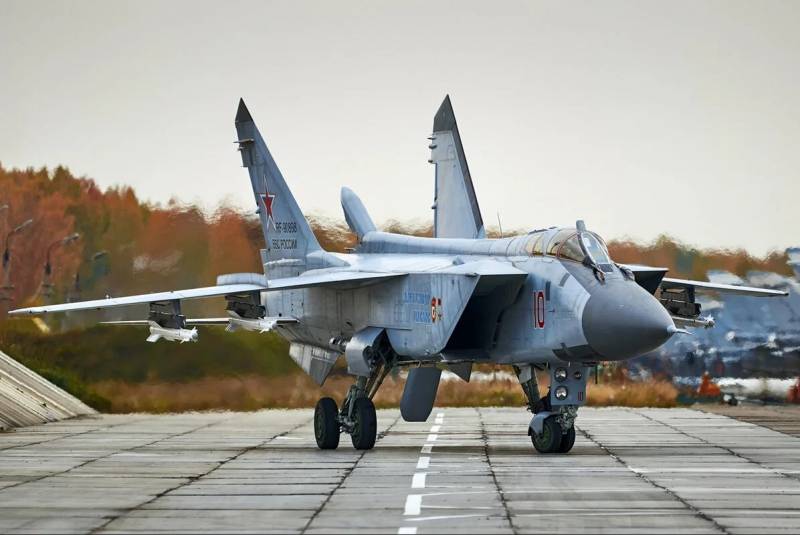
If you do not look at the design differences (and there are quite a lot of them), then the new interceptor differed from the MiG-25 primarily in three things:
- new electronic equipment (meaning the Barrier radar with PAR);
- the second member of the crew;
- gun GSh-6-23.
Zaslon is a breakthrough system that made the MiG-31 the first fighter with PAR and one of the best aircraft in the world as a whole, and not just in a small class of interceptors. And, as the practice of converting the MiG-31 into the Kinzhal hypersonic complex showed, the aircraft initially had a huge potential for development.
The second crew member is a useful solution, the pilot is not distracted from controlling the aircraft, and the operator does his job, which made the MiG-31 such a powerful machine in terms of interaction with other aircraft and ground systems. That is, in fact, the MiG-31 became the forerunner of the network-centric complexes of the 21st century, playing the role of precisely the basic element of such a complex.
Everything is quite logical, the gun does not fit into the picture.
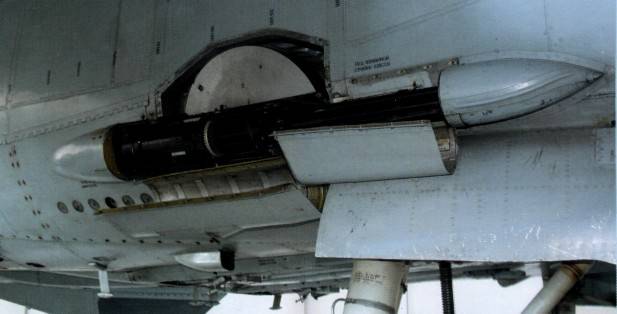
Indeed, the six-barreled GSh-6-23 mounted on the MiG-31 is surprising. The MiG-25 quite normally solved its tasks without a gun at all, with only missiles. An interceptor is not a fighter, a “dog dump” in which a cannon can be used is not his specialty, on the contrary, a fast, but not very maneuverable interceptor should by all means avoid such battles where he has many chances not to get out of the fight.
GSh-6-23 in general before the MiG-31 was installed on one aircraft, on the Su-24. And there, on a front-line bomber, it looked appropriate, because the Su-24 with its performance characteristics could use a six-barreled monster for attack. Moreover, Pavel Sukhoi was so satisfied with the GSh-6-23 that, in addition to the guns that were regularly installed in the Su-24 ammunition load, the so-called SPPU-6 cannon containers with movable gun mounts GSh-6-23M, capable of deviating along horizontal and vertical by 45 degrees.

It was assumed that with such weapons, and in total it was planned to place two such installations on a front-line bomber, he would be able to completely disable the runway in one go, or destroy a column of motorized infantry in combat vehicles up to one kilometer long.
But ground attack is not something an interceptor can do. He doesn't know how to do this at all. It and the 30-ton Su-24 with an attack from a cannon could have certain problems, but the MiG-31, which weighs 10 tons more and generally would not have succeeded in this.
Cruise missiles, which the MiG-31 was originally oriented to intercept? Well, that's the idea. Something from an opera about hand-to-hand combat for a paratrooper. The cruise missiles fly at fairly low altitudes, where the MiG-31 is an iron with an iron, and the detected missile launcher is easier to neutralize using a conventional missile with a thermal seeker, since something, and the engine of a cruise missile, unlike a ballistic missile, works throughout the entire route . And chasing a cruise missile on an interceptor and trying to shoot it down with a cannon ...
UAVs. Of course, when the MiG-31 was created about drones-kamikaze of this size, if they thought that the most frostbitten science fiction writers. But after 50 years, everything has changed so much that so much deadly plastic flies in the air (there is at least metal in the structures) that it takes you aback. But the MiG-31 remained the same. And, given that the UAVs firmly occupied the echelon up to 1 km, the interceptor is useless here. And even more so with a gun.
Of course, if we are talking about finding something like the RQ-4 "Global Hawk" in the boundless ocean of air and dropping it down carefully - yes, the MiG-31 is good here.
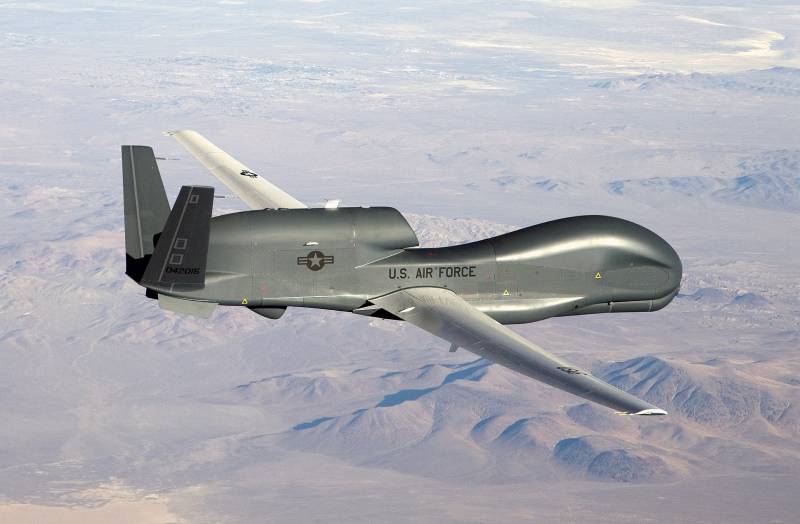
And the dimensions of the strategic spy are the same, and the heights at which he operates. You can spend a rocket on this, it’s not necessary to catch up and try on the tooth with a cannon.
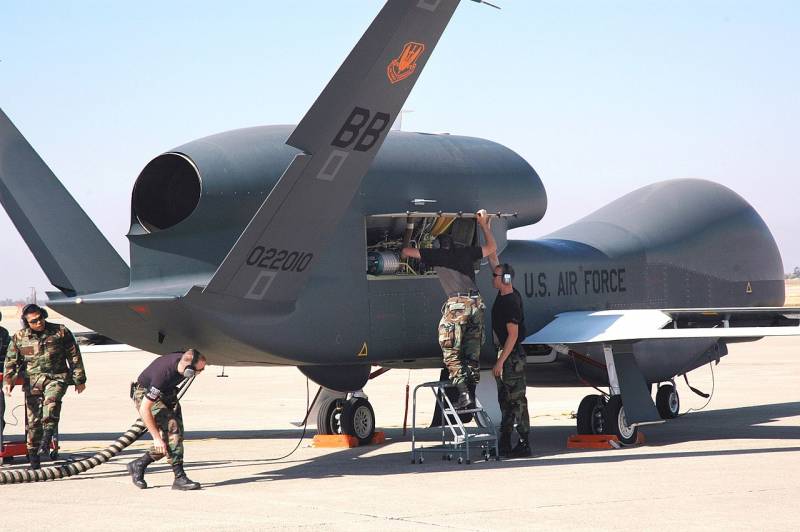
Moreover, the normal distance of using a gun is from 200 to 1200 meters. That is, almost point-blank in our time.
And now a completely logical question arises: why was a weapon installed on the MiG-31 that there was no one to use?
You can, of course, if necessary, pick up the American bombers with a cannon. But this is already completely out of the realm of fantasy, and the point is not even that in the event of a global batch, strategic bombers simply will not have time to fly to the launch site of their missiles, when everything will be finished, but that the Americans will soon not be able to fly on how. And in general, as recent practice has shown, stategs are much easier to intercept at their airfields, and not when they are in the air with a full load.
The answer, perhaps, will be somewhat drawn and will not seem entirely logical, but the MiG-31 began to be created precisely in those years when dozens of balloons were still roaming the sky, spying on everything that was happening on our territory. The regular MiG-25 interceptor simply could not, due to only missile weapons, effectively fight the ADA, because it was very difficult to aim the missile. So they installed the GSh-6-23, capable of flooding a certain amount of space with a stream of shells.
And then the targets somehow disappeared, but the gun remained. Put away? It doesn't make sense, it doesn't weigh that much.
And now fate has prepared for us the return of the "prodigal ball" performed by the Chinese military. Yes, this is no longer just a ball that flies at the behest of the wind, it can taxi, move in complete calm, change altitude, and so on. Moreover, at such a height that ordinary fighters are simply unable to climb.
And the metal is still at a minimum. And the missiles are still badly guided. And if someone else can stuff a small electronic warfare module into a basket so that it sings to the radars: “I am a cloud, a cloud, a cloud, I am not a bear at all” - and in general everything will be just fine. For the ball. Which just lost control, his batteries ran out, but there was no sun. Or the solar cells are broken.
No wonder our pragmatic neighbors howled with delight: “Give it, give it to us!”
True, China responded in the spirit of “Wake up, we only have five of them, we don’t have enough of them ourselves,” but an almost imperceptible ball that, at an altitude of 20 km, will drag explosives and drop them - how is that? Okay, if there is to Barvikha or Rublyovka, and if to the Kursk nuclear power plant? Or some factory?
Here and so, sorry, it flies so that it doesn’t seem enough. Air defense, of course, is doing everything it can, but what is the situation when it cannot?
In general, the MiG-31, with its high-altitude characteristics and everything else, will be relevant and in demand for a long time to come.
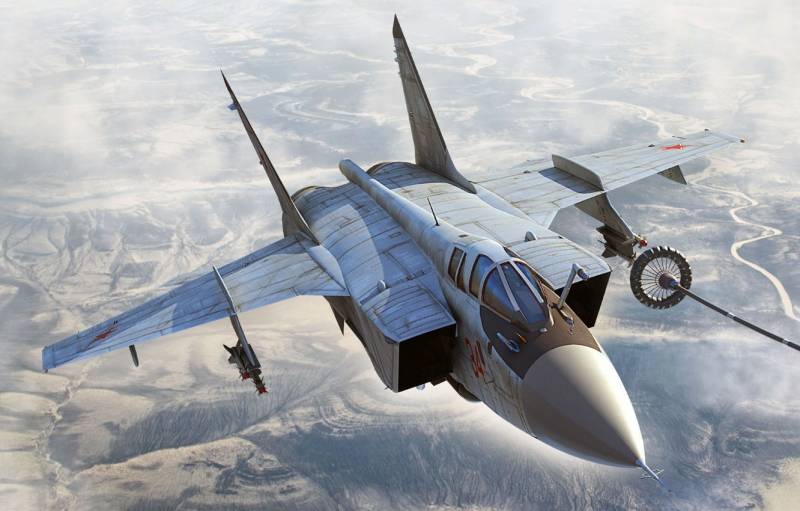
Surprisingly, what was laid down in the seventies of the last century suddenly turned out to be in demand 50 years later!
Thanks to the Americans from the CIA, who tyrannized the country with their reconnaissance balloons and balloons! At the very least, we have something to defend ourselves with.
For some reason, there is confidence that now everyone who watched this fascinating show in the sky over North America thought about the fact that here it is, a very interesting solution to many problems. And they will either start making balls themselves, or look for those who will make them.
Where such confidence? From the Iranian producers of "Shaheds" loaded for three years in advance. From the sudden surge of interest in South Korean solar cells.
Practice, which is better than any calculations, has shown that a small and very cheap UAV, which rumbles on a motorcycle engine at an altitude of 50 to 500 meters and carries 50 kg of explosives, is terrible. weapon, which is not so easy to knock down. This is an advantage over the enemy, whether explicit or potential.
A balloon that is hard to hit by radar and hard to target with missiles, that can carry anything, is also an advantage.
And these advantages must be leveled. Than - this is a separate question, but it is necessary.
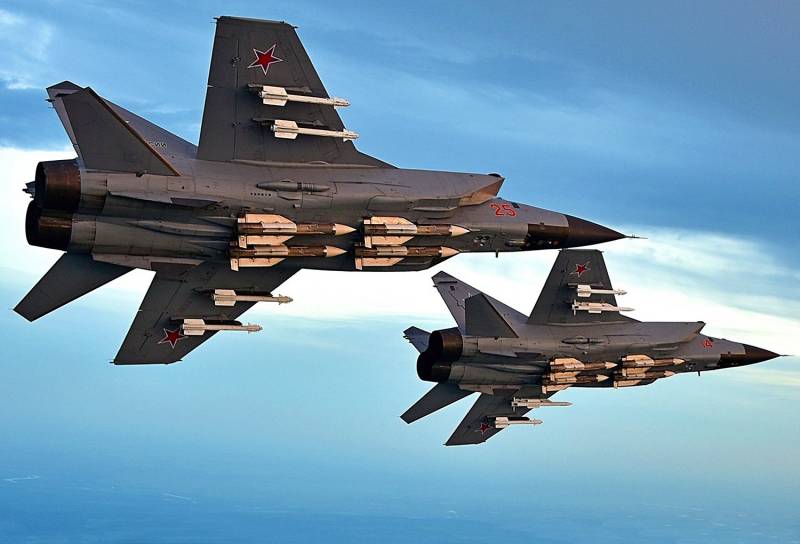
In our case, for the MiG-31, it really turned out to be some kind of “Back to the Future”. But, unlike many, we have a kind of time machine weighing over 40 tons. But there is, and this is generally pleasing.
Information